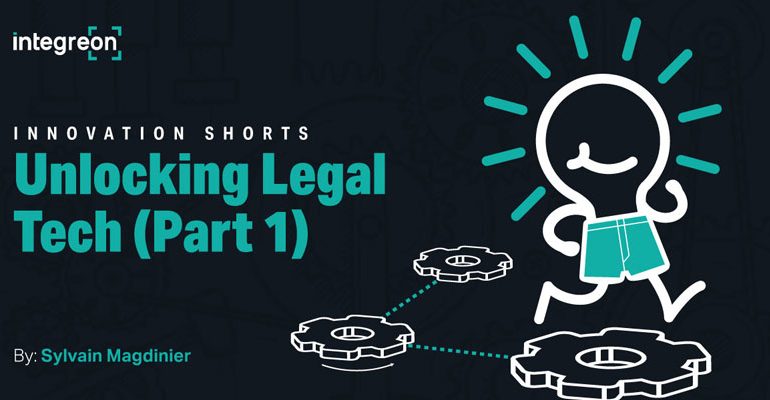Innovation Shorts: Think Differently, Raise Your Game
This month we celebrate the arrival at Integreon of Diane Homolak. Diane is a recovered lawyer, leader of multinational commercial contracting organizations, accredited project manager and veteran of countless legal technology implementation projects. Diane knows things about legal tech that even Wikileaks are afraid to publish.
But we are not afraid. In this article we are going to share some of Diane’s wisdom about how to make legal tech projects successful, regardless of the type of technology involved. Not only that, but we are going to keep the article down to a more bite-sized length, in recognition of the global crisis in attention spans.
So, assuming you are still reading at this point, here are 4 golden rules for every legal tech implementation.
Golden Rule 1: Know your Out-of-the-Box
A vendor of LegalTech knows their product functionality better than anyone. But clients know their own functional needs better than any vendor, and someone has to take responsibility for matching the former to the latter. That someone should be the client. Aim to know the tool’s out-of-the-box features at least as well as the vendor, so you can test their fitness for your requirements. The golden rule here is not to outsource this to the vendor, even if they are incredibly helpful and supportive. If the product does everything the vendor promises but your internal users end up being unhappy with the tool, it won’t be the vendor’s fault.
This is really about taking the vendor’s knowledge and turning it into your own wisdom. To quote the British journalist Miles Kington, knowledge is knowing that a tomato is a fruit; wisdom is not putting it into a fruit salad. There is an AI version of that joke but I didn’t understand the math involved.
Golden Rule 2: Understand the design compromises
Decent vendors will be open about some of the design compromises that their product has had to incorporate. These are not faults or defects, just a fact of life in the world of software engineering. For example:
- The tool can do X, but only if [these conditions] apply;
- You can change fields A, B and C in the template, but not the others.
Design compromises have a nasty habit of cropping up in areas of functionality that turn out to be important to the client. In the next issue of Innovation Shorts, we will be taking a closer look at this topic. But for now keep referring back to Golden Rule 1.
Golden Rule 3: Stay focused
Now I’m not saying that legal tech clients are like children. That would be both patronizing and a gross generalization. But they are. Let’s say the client team has been asked to start testing the tool prior to full deployment. The project has some clearly defined performance parameters, and a core set of functional features that the tool must deliver. But over here, there is a fancy button that does something extra. And Clive has just discovered that if you enable that drop-down menu you get a whole new landscape opening up.
The toy chest of functionality is like a portal to Planet Scope Creep. Pilot users get distracted by shiny new things, and before you know it the system configuration is becoming more complex and taking longer than planned. Stay focused on the main functional outcomes driving the project, and do not let additional features impinge on either the quality of user experience or the implementation timeline. If necessary, use stern language and withhold treats when users want to rummage around too deeply inside the toy chest.
Golden Rule 4: Manage change effectively, but manage expectations carefully
Change management experts often talk about the need to create organizational momentum that will drive the change program. Get the team excited. Appoint change champions. Create a sense of urgency. Hire Beyoncé for the kickoff meeting. There is no doubt that effective change management does involve staff engagement and positive energy. But at what cost? And by cost, we are not referring to megastar performance fees. Legal tech can be transformative, but good luck getting a return on that investment. No, we are talking about change psychology.
The issue is not that it is wrong to generate positive organizational energy behind the change program. It’s the problem of negative energy that surfaces when staff start to engage with the technology and hit a wall of frustration or disappointment. There are a few factors involved in this syndrome:
-
First, the work that goes into driving enthusiasm for the technology project tends to focus on the positives. Hardly surprising. You don’t get a queue of volunteers to become Premier Change Champions by telling them how angry some of their colleagues might get when they struggle with the tool “in the early stages”.
The trick is to create the enthusiasm first – establish buy-in – and then hit them with a dose of reality about what the journey will entail. Full commitment to the cause will push the project across the finish line, but the people doing the pushing are probably going to complain at some point that their backs are hurting.
-
Second, we return to Golden Rule no. 1. If there is a significant gap between tool functionality and client operational requirements, the level of frustration and disillusionment goes up incrementally in direct proportion to the level of enthusiasm and belief generated within the user team at the beginning. Get them excited about the journey but braced for the first few stops along the way.
-
Third, communications used in managing expectations up and down the organization have to be carefully calibrated for the audience. And the broader the tech deployment, the more the communications effort can go wrong. What motivates the executive team to commit their time to the implementation will likely be different from what excites the lawyers, paralegals and contracts professionals who may be using the tool day-to-day.
Effective change psychology is about understanding the impact of your communications and direction on the relevant audience. You can tell seasoned dinner guests that their starter will be Insalata Caprese. You can tell your kids they are going to have a salad with cheese and tomatoes. Don’t ever announce that you will be serving chunks of Mozzarella with some fruit on the side.
More Innovation Shorts to follow. Next time – Unlocking Legal Tech (Part 2)


